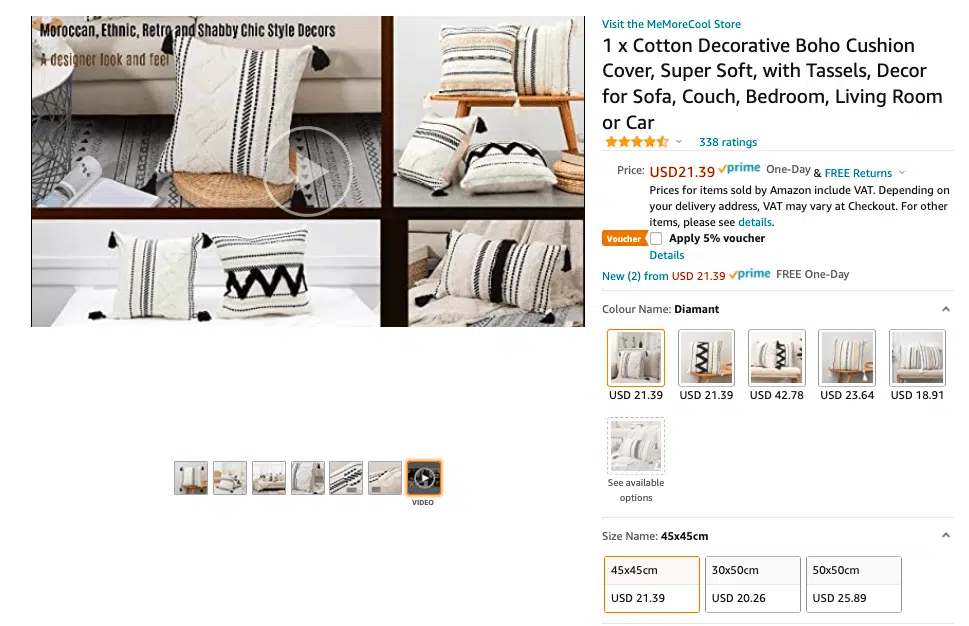The main goal of product listing variations on Amazon is to provide shoppers with a variety of buying selections in one listing. Let’s keep in mind that online consumers want choices. They don’t want only a product, but their choice of a product.
While some may want a medium-sized red shirt, others will prefer the black, XL-sized option. More likely than not, without item options, users will soon leave your listings and go to the Amazon seller that offers what they need.
So, why not give them all buying choices in a single product listing?
In this article, you’ll learn how to upload attractive variation listings on Amazon. Also, you’ll also find some great tips to boost conversions and drive sales.
Let’s dive right in!
What is a Variation Relationship Listing?
Amazon variation relationships deliver multiple selling options in one listing. The feature is also known as “parent-child listings.”

Here are a few reasons why Amazon sellers may use listing variations:
- They carry very similar product offers
- An item has more than one type or variation
- Products vary in a few, but specific features
- Related listings could share one title and description
- Shoppers expect to find the related items in one listing
- Related listings could share one title and description
Think of a pair of shoes featuring different sizes and colors. It’d be quite impractical to create a listing for each shoe size and color. Sellers can make things simple with variation listings.
That way customers don’t have to go back and forth through several listings. Rather, they can choose their ideal shoe size and color on the same product page.
Amazon Variation Listing Anatomy
Variation listings are built of three key elements:
- Parent ASIN. The main product listing that houses all item variations. It’s a non-buyable entity, which Amazon uses to catalog variations in a single listing.
- Child ASINs. Different instances related to the parent ASIN. Each has a specific distinction in the product listing. For example: color, size, flavor, shape, and so on.
- Variation Theme. States the difference between related products. Therefore, it appraises item variations (size, color, etc.) to separate the child ASINs from one another.
Here’s an example of how variations appear to shoppers:

Image source: Seller Central
How Can Sellers Benefits from Product Listing Variations on Amazon?
Many sellers rely on listing variations to improve customer experience. But that is not the only perk of using listing variations on Amazon.
Here are a few of the best advantages sellers can reap from this feature:
- Improved visibility. Brands can merge low-selling products as child ASINS to a high-performing listing. This is a great strategy to improve item discovery and sales.
- Drive conversions. Give users all the options they need at the top of the page. Such listings hold the user’s attention, and away from the competition.
- Combined product reviews. All child listing reviews will appear on the parent ASIN page. So, you can accumulate positive reviews from different variations to increase sales.
- Boost organic ranking. Product ratings are also cumulative. Therefore, every positive sale from a child ASIN will boost the parent listing’s search rank.
How to Create Variation Relationship Listings?
You can create Amazon variation listings on the Seller Central. Here are the steps to do it:
- Open the “Inventory” tab and choose “Add Products via Upload.”
- Download the proper stock file template. Here, create youth parent-child SKUs.
Keep in mind that the parent product should include the following data:
- All values for required fields. For instance: product name, brand, manufacturer, and SKU.
- Leave the “Parent SKU” field blank.
- Submit a ‘parent’ value in “Parentage”, and a valid value in “Variation Theme.”
- Leave the “Relationship Type” and non-required fields blank.
Now, enter the values for each child ASIN:
- Fill in all required fields.
- Submit the parent SKUs value in the “Parent SKU” fields. It should be the same for all child products.
- Submit a ‘child’ value in “Parentage”, and ‘variation’ in “Relationship Type.”
- Enter the variation value used for the parent ASIN in “Variation Theme”. This will be the same for all child items.
- Write any other values in the optional fields.
Once you’re done, upload the template to Seller Central.
Relationship listings in different categories:

Image source: Seller Central
Amazon Variation Wizard
Sellers can also use the Amazon Variation Wizard to ease up the process. This tool uses stock file templates to create parent-child listings in bulk.
You can access the variation wizard on Seller Central.

Here’s how to do so:
- Go to the “Inventory” tab and select “Add a Product.”
- Choose the “Add a Variation using Variation Wizard” option.
The process is very similar to the ‘manual’ approach to creating variations. However, the variation wizard automates the process, making it easier for sellers to create variation listings.
- Download the proper category template from Amazon’s Product Classifier.
- Create parent and child SKUs in the inventory template.
- Submit the following data for the parent product:
- Enter SKU and key values for required fields.
- Leave the “Parent SKU” field blank.
- Enter a ‘parent’ value in “Parentage”, and a valid value in “Variation Theme.”
- Leave the “Relationship Type” field blank.
- Upload the required data for each child ASIN:
- Enter the required values on each field.
- Use the parent SKUs value to fill the “Parent SKU” fields. It should be the same for all child products.
- Submit a ‘child’ value in “Parentage”, and ‘variation’ in “Relationship Type.”
- Enter the variation value used for the parent ASIN in “Variation Theme”. This will be the same for all child items.
Best Practices for Amazon Variations
Showcasing Amazon variations is not as easy as it seems. There’s a fine balance between too many or too few choices.
Let’s look at some key tips to make the most of your product variations on Amazon.
- Create focal points. Make the best-rated product the focus of your listing. In the end, this will attract more users who’ll then see your child ASINs.
- Work on your content. Modify variation descriptions if necessary. Maybe it’s one bullet point, or even one phrase. The goal is to ensure that each variation delivers honest information to customers.
- Use clear visuals. Upload high-quality images that display the product’s variations. Go with high-quality photos, and show customers the perks of each variation.
- Enhanced Brand Content. Variations with different themes may benefit from Amazon A+ content. You can create specific A+ pages for each variation. This will boost your content, and cater listings to many tastes.
- Monitor your listings. Keep track of variation performance in seller central. If sales remain stale, perhaps it’s best to switch back to traditional listings.
What Not to Do in a Variation Relationship Listing
We can’t stress enough how crucial it is to know what to avoid in a variation listing.
Here’s what you mustn’t do:
- Variation manipulation. Some sellers have been known to manipulate variations. They use them to boost sales on brand-new items, or to increase reviews for unrelated products. Amazon will remove your listings if you don’t follow its variation policy compliance.
- Listing unrelated products together. For example, don’t offer a portable charger with a charging cable. Yes, they are related items, but they are not the same product.
- Use variation themes properly. If you create a color and size variation, do not add an unrelated theme to your listing. The marketplace may consider that confusing, or even misleading.
- Avoid poor-rated item variations. Merging poor-rated items with high-rating items is against Amazon’s policies. will only reduce the listing’s rating.
- Make it simple. Variations must be easy to navigate, and clearly different from each other. Make sure each variation states the product difference with clear images and descriptions.
- Don’t overdo it. Avoid using several variation themes. Keep a clean listing that does not frustrate consumers with excessive choices.
Final Thoughts
The strategies we reviewed will help you make the most of your parent-child ASINs; simply because variation listings are the best way to showcase related products.
Look at it this way: you’ll simplify shopping for customers, and keep them in your sales funnel. But, there’s more benefits you’ll reap from Amazon variation listings:
- Improve brand visibility
- Boost your ROI
- Scale up in the search ranks
- Drive sales and revenue
- Increase user conversions
Thanks to variations, customers will find what they need in your listings. No more long and slow searches! Plus, you’ll sell more stock, and boost your brand awareness in the marketplace.
Author

Esteban Muñoz is an SEO copywriter at AMZ Advisers, with several years’ experience in digital marketing and e-commerce. Esteban and the AMZ Advisers team have been able to achieve incredible growth on the Amazon platform for their clients by optimizing and managing their accounts and creating in-depth content marketing strategies.



